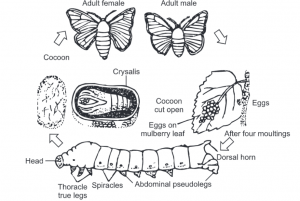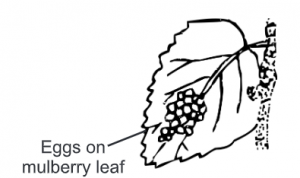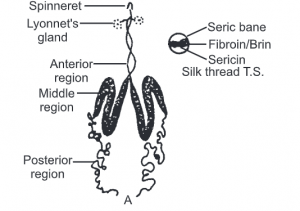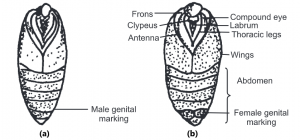External Morphology of Bombyx mori
- The adult moth of Bombyx mori L. is about 25.00 mm long with a wingspan of 40.00 to 50.00 mm from side to side and fat-bodied. The male silk moths are smaller in size than females. The moth is quite robust and creamy white in colour.
- The body is distinctly divisible into three regions, viz., head, thorax and abdomen. The head possesses a pair of compound eyes, a pair of bushy (branched) or feathery antennae.
- The females have smaller antennae and mouthparts with a long proboscis. The thorax is three-segmented and bears three pairs of legs (five segmented each) and two pairs of wings the meso and meta-thoracic, the front pair overlapping the hind pair when the moth is in the resting position.
- The cream coloured wings are about 25.00 mm long and are marked by several faint or brown lines.
- In the male, eight abdominal segments are visible and in the female, seven. There are six pairs of spiracles present laterally on either side of the body. The Female has a comparatively fatter and larger abdomen.
- At the caudal end, the male moth has a pair of hooks known as Harpes whereas the female moth has a knob-like projection with sensory hairs. The female is generally less active than the male. The entire body of both is covered by minute scales.
Life Cycle of B. mori
- The silkmoth is dioecious i.e. the sexes are separate. Fertilization is internal, preceded by copulation.
- Silkworms pass through a complete metamorphosis (Holometabolous) from the egg to the adult stage through two intermediate stages of larva (caterpillar) and pupa (cocoon) (Fig. 1).
Eggs:
- Each female can lay 300 to 400 small, smooth, sub-spherical yellowish eggs, either in free or agglutinated conditions. The eggs are tiny and weigh around 2,000 eggs in a gram.
- They measure 1 to 1.3 mm in length and 0.9 to 1.2 mm in width. The eggs of European races are comparatively larger and heavier.
Silkworm eggs are of two types:
(a) Hibernating eggs: Deposited in spring, which undergo diapauses and hatch out only in next spring.
(b) Non-hibernating eggs: Derived from successive generations without any pause in a year.

- The egg contains a good amount of yolk and is covered by a smooth hard chitinous shell. After laying the eggs, the female moth does not take any food and dies within 4-5 days. ;
- In the univoltine (a single brood per year) they may take months 7 because over-wintering takes a place in this stage but the multivoltine broods come out after 10-12 days. From the egg, mulberry leaf hatches out a larva called the caterpillar.

Larvae:
- Eggs when first laid, are bright yellow in colour and under the influence of suitable temperature, embryonic development takes place and the colour changes from yellow to brown, then to grey.
- At summer temperatures, the eggs hatch in 10 days. On the completion of development, the newly hatched caterpillar is black or dark brown.
- It has a large head and the body is rough, wrinkled and densely covered with bristles so that it looks like a hairy caterpillar and is polypod type. It measures about 4 to 6 mm in length.
- The full grown larva is about 6 to 8 cm in length. The body of larva is divisible into a prominent head, distinctly segmented thorax and an elongated abdomen. The head bears mandibulate mouthparts and three pairs of ocelli.
- A distinct hook-like structure, the spinneret, is present for the extrusion of silk from the inner silk gland.[Fig3(a)]

- The thorax forms a hump and consists of three segments. Each of the three thoracic segments bears pair of jointed true legs.
- The tip of each leg has a recurved hook for locomotion and ingestion of leaves. The abdomen consists of ten segments of which first nine are clearly marked, while the tenth one is indistinct.
- The 3% 4% 5″ 6″ and 9″ abdominal segments bear ventrally a pair of unjointed stumpy appendages each.
- These are called prolegs or pseudo legs. Each leg is retractile and more or less cylindrical. The eighth segment carries a short dorsal anal horn. A series of respiratory spiracles or ostia are present on either lateral side of the abdomen.
- The larva is a voracious eater and strongly gregarious. In the beginning, chopped young mulberry leaves are given as food but with the advancement of age, entire and matured leaves are provided as food. The caterpillar moves in a characteristic looping manner. The larval life lasts for 3-4 weeks (30-40 days).
- During this period, the larva moults four times. After each moult, the larva grows rapidly. A full-grown larva is about 8.00 cm long and becomes transparent and golden brown in appearance.
- A pair of long sac-like silk-glands now develops into the lateral side of the body inside. These are modified salivary glands. The little caterpillar, immediately after hatching begins to consume 30,000 times its own weight of mulberry leaves and grows rapidly.

Pupae:
- The full grown larva now stops feeding and becomes restless and if given a suitable place, such as dried bushy plants or Bamboo mountage (Chandrika), they soon begin to spin their cocoons.
- This takes about 3 days of constant motions of the head from side to side at the rate of about 65 per minutes. The cocoon is formed from a secretion from two large silk glands which are transformed labial glands (= salivary glands).
- These extend along the inside of the body and open through a common duct of the spinneret on the lower lip [Fig. 4(a)]. As the clear viscous fluid is exposed to the air, it hardens into the fine silk fibre.
- Each silk gland extrudes a fine filament of pulpy material called brin or fibroin and two such brins are stuck together by sericin or silk gum in the spinnerette to form a single continuous fibre known as the seric bane about 500 m long and 0.02 mm wide. Temperature and humidity influence the speed of spinning and the quality of silk.
- The cocoons are oval and vary in colour, according to strain or race; from white to a beautiful golden yellow. The silk spinning activity of silkworms is a physiological function by which larvae probably get rid of excess protein acquired from the mulberry leaves during the period of their growth.
- The cocoon also provides protection for the developing pupa.
- The pupal stage is generally called the resting, inactive stage of the silkworm when it is incapable of feeding and appears quiescent.
- This stage is a transitional phase during which definite changes take place ie. internal organs undergo a complete change and assume the new form of the adult moth.
- The mature silkworm larva passes through a short transitory stage of pre-pupa before becoming a pupa. During this prepupal stage, the dissolution of the larval organs takes place and this is followed by the formation of adult organs during the pupal stage.
- Soon after pupation the pupa is white in colour and soft but gradually turns brown to dark brown and the pupal skin becomes harder.
- The prominent morphological parts visible on pupa are a pair of large compound eyes, a pair of large antennae, fore and hind wings and the legs. Ten abdominal segments can be seen on the ventral side, but only nine seen from dorsal side. Seven pairs of spiracles are also seen on abdomen.

Adult:
- Within the cocoon the pupa shrinks in length and in about 10-15 days a full-fledged moth emerges through an opening in the end of the cocoon.
- The cocoons from which the moth emerges are called pierced cocoons. They are of low value because they cannot be reeled, but they are carded and made into thread. The ashy-white moth has a fat body and wing expanse of about 5 cm.
- It takes no food and rarely attempts to fly but has high capacity for reproduction. The external features are described in external morphology of moth earlier.
